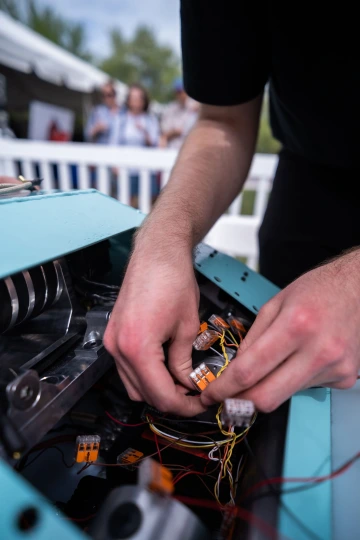Capstone Team Scores Knockouts at Battlebot Destruct-a-Thon and Design Day

Team 23037 at Craig M. Berge Design Day, where the students won the L3Harris Commercial Aviation Solutions Award for Most Robust Systems Engineering.
Engineering Capstone Team 23037 scored back-to-back knockouts with its 250-pound robot at the inaugural Battlebots: Destruct-a-Thon competition in Las Vegas. On May 6 and 7, the team of six University of Arizona engineering students drove the stingray-shaped BattleBot "Disarray" to undefeated victory. The students are now applicants for the BattleBots World Championship.
But a fighting robot isn’t the only thing Team 23037 created for their Interdisciplinary Capstone project. In addition to their BattleBot, they laid the foundation for the Wildcat Robotics club, inspiring future engineering students to get in the arena.
The capstone team aims to get on the BattleBot TV show, which features one-on-one remote-controlled fights between specially designed robots.
Team 23037 consists of mechanical engineering students Nick Sivertson, Al Hurworth and Alex Wait, electrical and computer engineering students Yousuf Choudhary and Karson Knudson, and aerospace engineering student Mathias Ramirez. Each student, now a new graduate, had a unique responsibility on the team, from safety standards to weapons lead.
Only two of the six students had worked on robots before. But now they know the entire process, from design to machining to combat testing.
“It was very hard to get this entire project done in one year. With a lot of integration, the team really learned from each other,” said Sivertson, the project lead. “We had some strengths in manufacturing, as well as software, that brought it all together.”

Originally codenamed “Sting,” the robot's design shifted multiple times over the school year, both to align with the TV show's rules, and as a natural result of fine-tuning. Once designed to be nearly 400 pounds, Disarray now weighs in at 250 pounds and can drive up to 20 miles per hour. Its weapon uses a belt system to swing hooks from underneath, which can either gouge the enemy robot, or as in the competition, completely flip over the opponent.
But, as the team puts it, "with great power comes great responsibility," so Disarray is also equipped with kill switches, safety fuses and critical part protection.
“You don’t really realize how heavy it is and how big it is until you’re working on it,” Sivertson said. “That first time you see it drive – like it’s five pounds or less – it’s kind of wild to think about.”
The Wildcat Robotics club is already designing two new BattleBots for future engineering students. Following in Disarray’s trail, the new BattleBots are also inspired by animals: the 12-pound "Gila" and the 3-pound "Buzz Kill," both of which will sport vertical spinner weapons. These “first year” robots are estimated for completion this summer.
“One of the big things about the project is that we wanted to build a BattleBot, but at the same time, we wanted to leave a lasting thing at the university,” Hurworth said in an interview with El Indie. “I really wanted to make sure that other students coming in that are interested in robotics have the opportunity to learn and grow.”
Team advisor and ECE Regents Professor Michael Marcellin says this is the first time he’s seen a student group set on creating a club in addition to working on a capstone project. Team 23037 received funding from Marcellin as well as Craig M. Berge Dean of the College of Engineering David Hahn, through the Craig M. Berge Dean’s Fund.
Showing off its robot at the 2023 Craig M. Berge Design Day, Team 23037 also took home the $2,500 L3Harris Commercial Aviation Solutions Award for Most Robust Systems Engineering.“In 35 years at the University of Arizona, this is probably the most impressive group of undergrads that I’ve worked with. What they accomplished in one academic year is remarkable,” Marcellin said. “Even if they hadn’t won the fight, I would have said that.”

